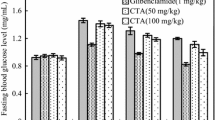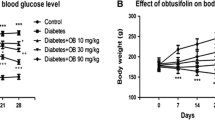Abstract
Rutin, a polyphenolic flavonoid, was investigated for its antioxidant potential in streptozotocin (STZ)-induced diabetic rats. Rats were rendered diabetic by a single intraperitoneal injection of streptozotocin (50 mg/kg). The levels of fasting plasma glucose and insulin were estimated. Lipid peroxidative products and antioxidants were estimated in liver, kidney and brain. Histopathological studies were carried out in these tissues. A significant (p < 0.05) increase in the levels of fasting plasma glucose, lipid peroxidative products (thiobarbituric acid reactive substances [TBARS] and lipid hydroperoxides [HP]) and a significant (p < 0.05) decrease in plasma insulin, enzymic antioxidants (superoxide dismutase [SOD], catalase, glutathione peroxidase [GPx] and glutathione reductase [GRx]) and nonenzymic antioxidants (reduced glutathione [GSH], vitamin C and E) in diabetic liver, kidney and brain were observed. Oral administration of rutin (100 mg/kg) for a period of 45 days significantly (p < 0.05) decreased fasting plasma glucose, increased insulin levels and improved the antioxidant status of diabetic rats by decreasing lipid peroxidative products and increasing enzymic and nonenzymic antioxidants. Normal rats treated with rutin (100 mg/kg) showed no significant (p < 0.05) effect on any of the parameters studied. Histopathological studies of the liver, kidney and brain showed the protective role of rutin. Thus, our study clearly shows that rutin has antioxidant effect in STZ-induced experimental diabetes.
Similar content being viewed by others
References
World Health Organization/International Diabetes Federation: The Economics of Diabetes and Diabetes Care - A Report of the Diabetes Health Economics Study Group. WHO, Geneva, 1999
Craig WJ: Health-promoting properties of common herbs. Am J Clin Nutr 70: 491s–499s, 1999
Szkudelski T: The mechanism of alloxan and streptozotocin action in β-cells of the rat pancreas. Physiol Res 50: 536–546, 2001
Baynes JW: Role of oxidative stress in development of complications of diabetes mellitus. Diabetes 40: 405–412, 1991
Potter JD: Cancer prevention: epidemiology and experiment. Cancer Lett 114: 7–9, 1997
Harborne JB: Plant phenolics. In: EA Bell and BV Charlwood (eds). Encyclopedia of plant physiology, Vol. 8. Secondary plant products. Springer Verlag, Berlin, 1986, pp. 329–395
Rice-Evans C, Packer L: In: Flavonoids in health and diseases, Marcel Decker Inc., New York, 1998, pp. 483–522
Middleton E, Kandaswami C, Theoharides TC: The effects of plant flavonoids on mammalian cells: Implications for inflammation, heart disease and cancer. Pharmacol Rev 52: 673–751, 2000
Hollman PC, Katan MB: Absorption, metabolism and bioavailability of flavonoids. In: C Rice-Evans and L Packer (eds). Flavonoids in Health and Disease, Marcel Decker, New York, 1998, pp. 483–522
Havsteen B: Flavonoids, a class of natural products of high pharmacological potency. Biochem Pharmacol 32: 1141–1148, 1983
Nakamura Y, Ishimitsu S, Tonogai Y: Effects of quercetin and rutin on serum and hepatic lipid concentrations, fecal steroid excretion and serum antioxidant properties. J Health Sci 46: 229–240, 2000
Hertog MG, Hollman PC, Katan MB, Kromhout D: Intake of potentially anticarcinogenic flavonoids and their determinants in adults in The Netherlands. Nutr Cancer 20: 21–29, 1993
Erlund I, Kosonen T, Alfthan G, Perttunen KM, Kenraali J, Parantainen J, Aro J: Pharmacokinetics of quercetin from quercetin aglycone and rutin in healthy volunteers. Eur J Clin Pharmacol 56: 545–553, 2000
Deschner EE, Ruperto J, Wong G, Newmark HL: Quercetin and rutin as inhibitors of azoxymethanol-induced colonic neoplasia. Carcinogenesis 12: 1193–1196, 1991
Aleksandrov PN, Speranskaia TV, Bobkov Iu G, Zagorevskii VA, Zykov DA: Effect of rutin and esculamine on models of aseptic inflammation. Farmakol Toksikol 49: 84–86, 1986
Di Carlo G, Autore G, Izzo AA, Maiolino P, Mascolo N, Viola P, Diurno MV, Capasso F: Inhibition of intestinal motility and secretion by flavonoids in mice and rats: structure-activity relationships. J Pharm Pharmacol 45: 1054–1059, 1993
Bear WL, Teel RW: Effects of citrus flavonoids on the mutagenicity of heterocyclic amines and on cytochrome P450 1A2 activity. Anticancer Res 20: 3609–3614, 2000
Pozin VM, Skuratovskaia SG, Pocheptsova GA: Changes in the vascular wall and ischemic damages to the myocardium in reversible episodes of heart muscle ischemia. Fiziologicheskii Zhurnal 42: 10–16, 1996
Chen S, Gong J, Liu F, Mohammed U: Naturally occurring polyphenolic antioxidants modulate IgE-mediated mast cell activation. Immunology 100: 471–480, 2000
Janbaz KH, Saeed SA, Gilani AH: Protective effect of rutin on paracetamol- and CCl4-induced hepatotoxicity in rodents. Fitoterapia 73: 557–563, 2002
Gao Z, Xu H, Huang K: Effects of rutin supplementation on antioxidant status and iron, copper, and zinc contents in mouse liver and brain. Biol Trace Elem Res 88: 271–279, 2002
Nagasawa T, Tabata N, Ito Y, Nishizawa N, Aiba Y, Kitts DD: Inhibition of glycation reaction in tissue protein incubations by water soluble rutin derivative. Mol Cell Biochem 249: 3–10, 2003
Nagasawa T, Tabata N, Ito Y, Aiba Y, Nishizawa N, Kitts DD: Dietary G-rutin suppresses glycation in tissue proteins of streptozotocin-induced diabetic rats. Mol Cell Biochem 252: 141–147, 2003
Kamalakkannan N, Stanely Mainzen Prince P: The antihyperglycaemic and antioxidant effect of rutin, a polyphenolic flavonoid, in streptozotocin-induced diabetic Wistar rats. Basic Clin Pharmacol Toxicol 98: 97–103, 2006
Sridhar SB, Sheetal UD, Pai MRSM, Shastri MS: Preclinical evaluation of the antidiabetic effect of Eugenia jambolana seed powder in streptozotocin-diabetic rats. Brazilian J Med Biol Res 38: 462–468, 2005
Fraga CG, Leibovitz BE, Toppel AL: Lipid peroxidation measured as TBARS in tissue slices. Characterisation and comparison with homogenate and microsome. Free Radic Biol Med 4: 155–161, 1988
Jiang ZY, Hunt JV, Wolff SP: Ferrous ion oxidation in the presence of xylenol orange for detection of lipid hydroperoxide in low density lipoprotein. Ann Biochem 202: 384–387, 1992
Ellman GL: Tissue sulfhydryl groups. Arch Biochem Biophys 82: 70–77, 1959
Omaye ST, Turnbull TD, Sauberlich HE: Selected method for the determination of ascorbic acid in animal cells, tissues and fluids. In: D.B. McCormic and D.L. Wright (eds). Methods in Enzymology, Academic press, New York, 1979, pp. 3–11
Baker H, Frank O, Angelis B, Feingold S: Plasma tocopherol in man at various times after ingesting free or acetylated tocopherol. Nutr Rep Int 21: 531–536, 1951
Kakkar P, Das B, Viswanathan PN: A modified spectrophotometric assay of SOD. Indian J Biochem Biophys 21: 130–132, 1984
Sinha KA: Colorimetric assay of catalase. Ann Biochem 47: 389–394, 1972
Rotruck JT, Pope AL, Ganther HE, Swanson AB: Selenium: Biochemical roles as a component of glutathione peroxidase. Science 179: 588–590, 1984
Horn HD, Burns FH: Assay of glutathione reductase activity. In: HV Bergmeyer (ed). Methods of Enzymatic Analysis, Academic Press, New York, 1978, p. 142
Korkina LG, Afanas'ev IB: Antioxidant and chelating properties of flavonoids. Adv Pharmacol 38: 151–163, 1997
Ferrali M, Signofrini C, Caciotti B, Sugherini L, Ciccoli D, Giachetti D, Comporti M: Protection against oxidative damage of erythrocyte membranes by the flavonoid quercetin and its relation to iron chelating activity. FEBS Letters 416: 123–139, 1997
Elliott AJ, Scheiber SA, Thomas C, Pardini RS: Inhibition of glutathione reductase by flavonoids. Biochem Pharmacol 44: 1603–1608, 1992
Kozlov AV, Ostrachovitch EA, Afanas'ev IB: Mechanism of inhibitory effects of chelating drugs on lipid peroxidation in rat brain homogenates. Biochem Pharmacol 47: 795–799, 1994
Aliciguzel Y, Ozen I, Aslan M, Karayalcin U: Activities of xanthine oxidoreductase and antioxidant enzymes in different tissues of diabetic rats. J Lab Clin Med 142: 172–177, 2003
Maritim AC, Sanders RA, Watkins III JB: Effects of α-lipoic acid on biomarkers of oxidative stress in streptozotocin-induced diabetic rats. J Nutr Biochem 14: 288–294, 2003
Santini SA, Marra G, Giardina B, et al.: Defective antioxidant defenses and enhanced susceptibility to lipid peroxidation in uncomplicated IDDM. Diabetes 46: 1853–1858, 1997
Kamalakkannan N, Stanely Mainzen Prince P: Antidiabetic and antioxidant activity of Aegle marmelos extract in streptozotocin induced diabetic rats. Pharm Biol 42: 125–130, 2004
Yadav P, Sarkar S, Bhatnagar D: Action of Capparis deciduas against alloxan-induced oxidative stress and diabetes in rat tissues. Pharmacol Res 36: 221–228, 1997
Gumieniczek A: Effects of repaglinide on oxidative stress in tissues of diabetic rabbits. Diab Res Clin Pract 68: 89–95, 2005
Sen CK: Nutritional biochemistry of cellular glutathione. J Nutr Biochem 8: 660–672, 1997
Dominguez C, Ruiz E, Gussinye M, Carrascosa A: Oxidative stress at onset and in early stages of type I diabetes in children and adolescents. Diab Care 21: 1736–1742, 1998
Fang YZ, Yang S, Wu G: Free radicals, antioxidants and nutrition. Nutrition 18: 872–879, 2002
Evelson P, Susemihl C, Villarreal I, Llesuy S, Rodriguez R, Peredo H, Lemberg A, Perazzo J, Filinger E: Hepatic morphological changes and oxidative stress in chronic streptozotocin-diabetic rats. Ann Hepatol 4: 115–120, 2005
Author information
Authors and Affiliations
Corresponding author
Rights and permissions
About this article
Cite this article
Kamalakkannan, N., Prince, P.S.M. Rutin improves the antioxidant status in streptozotocin-induced diabetic rat tissues. Mol Cell Biochem 293, 211–219 (2006). https://doi.org/10.1007/s11010-006-9244-1
Received:
Accepted:
Published:
Issue Date:
DOI: https://doi.org/10.1007/s11010-006-9244-1




